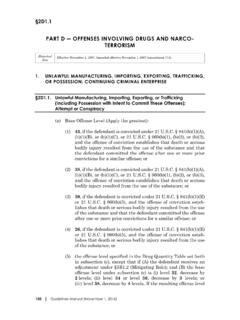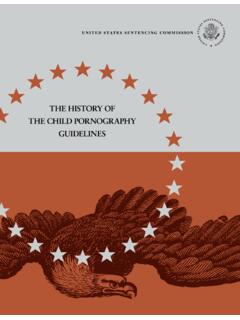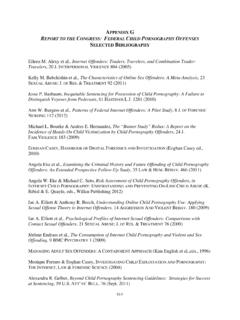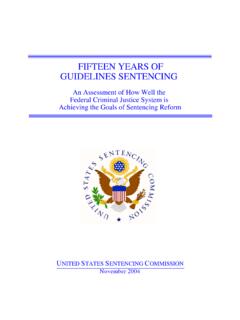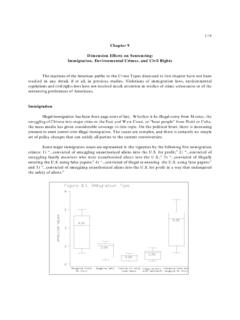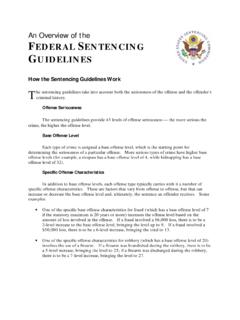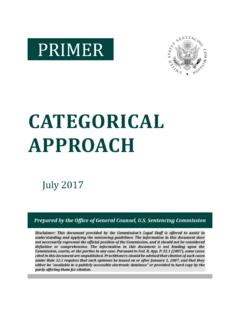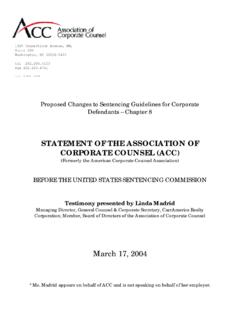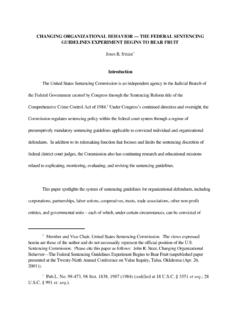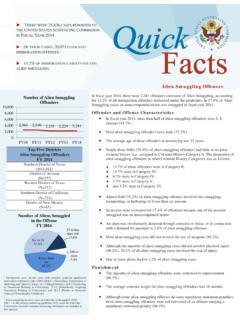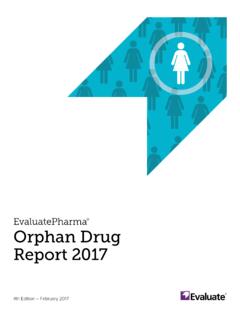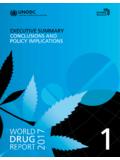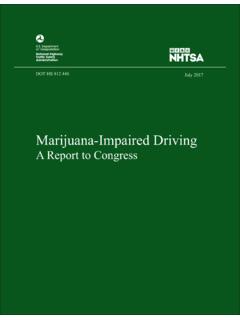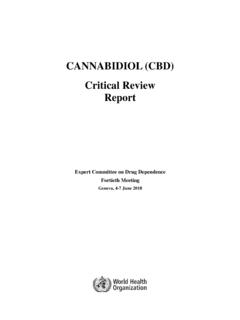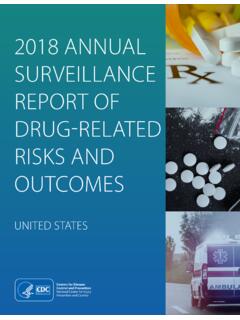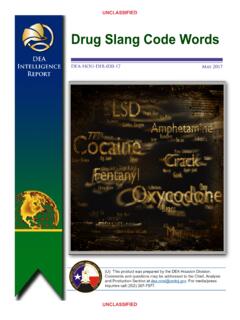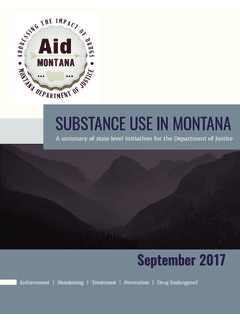Transcription of MANDATORY MINIMUM PENALTIES FOR DRUG OFFENSES
1 MANDATORY MINIMUM PENALTIES FOR drug OFFENSESin the FEDERAL CRIMINAL JUSTICE SYSTEMU nited StateS Sentencing commiSSionoctober 2017 MANDATORY MINIMUM PENALTIES for drug offensesin the federal Cri Minal JustiCe systeMWilliaM h . Pryor, Jr. Acting Chair raChel e . BarkoW CommissionerCharles r . BreyerCommissionerdanny C. reevesCommissionerJ. PatriCia Wilson sMoot Ex Officio ZaChary Bolitho Ex Officio kenneth P. CohenStaff DirectorO cto b e r 2 017 Table of ConTenTs1 seCTion one: inTroduCTion 3 seCTion Two: Key findings 9 seCTion Three: drug MANDATORY MiniMuMs in The federal sys TeM 10 Statutory MANDATORY MINIMUM Provisions Applicable to Federal drug OFFENSES 10 Penalty Provisions 11 Statutory Relief Provisions12 Guideline Provisions13 seCTion four: daTa analysis 14 The Commission s Updated Study of drug MANDATORY MINIMUM Penalties14 Recent Trends in MANDATORY MINIMUM PENALTIES 18 Prevalence of drug OFFENSES Carrying MANDATORY MINIMUM PENALTIES 18 How Often Are drug Offenders Charged with an Offense Carrying a MANDATORY MINIMUM Penalty?
2 22 How Severe Were MANDATORY MINIMUM PENALTIES for drug Offenders? 24 Where Were Offenders Convicted of drug OFFENSES Carrying MANDATORY Minimums? 25 Offender Demographics 25 Race, Gender, and Citizenship 27 Age27 Criminal History and Offense Characteristics 27 Criminal History 29 Offense Characteristics30 Relief from MANDATORY MINIMUM PENALTIES 32 Demographics 35 Substantial Assistance 36 Sentencing of Offenders Convicted of an Offense Carrying a drug MANDATORY MINIMUM Penalty 36 Average Sentence Length 40 Sentences Relative to the Guideline Range43 Offender Function 45 Distribution of Offender Function 46 Prevalence of OFFENSES Carrying drug MANDATORY MINIMUM PENALTIES by Offender Function 48 Relief from MANDATORY MINIMUM PENALTIES by Offender Function 50 Average Sentence Length by Offender Function51 Impact of drug MANDATORY MINIMUM PENALTIES on the Federal Prison Population 52 Federal drug Offender Population Overall 53 drug MANDATORY MINIMUM Offenders in the Federal Prison Population 57 drug MANDATORY MINIMUM Offenders in the Federal Prison Population By Race 57 drug MANDATORY MINIMUM Offenders in the Federal Prison
3 Population By Gender 59 drug MANDATORY MINIMUM Offenders in the Federal Prison Population By Citizenship 62 Recidivism 65 seCTion five: ConClusion 67 endnoTes 79 appendiCes79 Appendix A: drug MANDATORY MINIMUM PENALTIES in Each Circuit and District83 Appendix B: Average Age of drug Offenders at Sentencing 85 Appendix C: Length of drug MANDATORY MINIMUM Penalty by Offender Function 87 Appendix D: Powder Cocaine Offenders103 Appendix E: Crack Cocaine Offenders119 Appendix F: Marijuana Offenders135 Appendix G: Methamphetamine Offenders151 Appendix H: Heroin OffendersiUnited States Sentencing CommissionMandatory MINIMUM PENALTIES for federal drug OFFENSES ( 2017 )1 Introduction2 United States Sentencing CommissionMandatory MINIMUM PENALTIES for federal drug OFFENSES ( 2017 )IntroductionIn July 2017 , the Commission published its Overview of MANDATORY MINIMUM PENALTIES in the Federal Criminal Justice System ( 2017 Overview Publication),1 which was the first in a series of publications on MANDATORY MINIMUM The 2017 Overview Publication built on the Commission s 2011 report to the Congress: MANDATORY MINIMUM PENALTIES in the Federal Criminal Justice System (2 011 MANDATORY MINIMUM report ).
4 3 The 2011 report , which was submitted pursuant to a Congressional directive,4 provided detailed historical analyses of the evolution of federal MANDATORY minimums, scientific literature on the topic, and extensive analysis of the Commission s own data, public comment, and expert testimony. It further analyzed data related to each of the primary OFFENSES carrying MANDATORY MINIMUM PENALTIES , and, in the chapter devoted to drug OFFENSES , provided information about drug MANDATORY minimums overall and separately by drug type. The 2017 Overview Publication highlighted recent trends in the charging of OFFENSES carrying MANDATORY MINIMUM PENALTIES and provided updated sentencing data demonstrating the impact of those PENALTIES , supplementing the analysis presented in the 2011 MANDATORY MINIMUM report . This publication, the second in the series, focuses on the application of MANDATORY MINIMUM PENALTIES specifically to drug OFFENSES ,5 which are the most common OFFENSES carrying MANDATORY MINIMUM PENALTIES in the federal system.
5 As reflected in the 2017 Overview Publication, drug OFFENSES have accounted for approximately two-thirds of the OFFENSES carrying a MANDATORY MINIMUM penalty in recent years, significantly higher than the next largest class of Using fiscal year 2016 data, this publication includes analysis similar to that provided in the 2017 Overview Publication, providing sentencing data on OFFENSES carrying drug MANDATORY minimums, the impact on the Federal Bureau of Prisons (BOP) population, and differences observed when analyzing each of five main drug types. Where appropriate, the publication highlights changes and trends since the Commission s 2011 MANDATORY MINIMUM report . Because drug OFFENSES are the most common OFFENSES carrying MANDATORY MINIMUM PENALTIES , many of the trends in this publication mirror the trends seen in the 2017 Overview Publication. In addition to reporting general data regarding the use of drug MANDATORY MINIMUM PENALTIES , the Commission also analyzed the functions performed by drug offenders as part of their This function analysis provides a more complete profile of federal drug offenders and examines the use and impact of MANDATORY MINIMUM PENALTIES on offenders with differing levels of Key Findings4 United States Sentencing CommissionMandatory MINIMUM PENALTIES for federal drug OFFENSES ( 2017 )Key FindingsBuilding directly on its previous reports and the analyses set forth in the 2017 Overview Publication, this publication examines the use and impact of MANDATORY MINIMUM PENALTIES for drug OFFENSES .
6 As part of this analysis, the Commission makes the following key findings:Key Findings1. drug MANDATORY MINIMUM PENALTIES continued to result in long sentences in the federal system. In fiscal year 2016, over half ( ) of offenders convicted of an offense carrying a drug MANDATORY MINIMUM penalty faced a MANDATORY MINIMUM penalty of ten years or greater. In fiscal year 2016, the average sentence for offenders who were convicted of an offense carrying a drug MANDATORY MINIMUM penalty was 94 months of imprisonment, more than double the average sentence (42 months) for drug offenders not convicted of an offense carrying a MANDATORY MINIMUM penalty. Offenders who qualified for relief received significantly lower sentences (64 months) than those offenders who remained subject to a MANDATORY MINIMUM penalty at sentencing (126 months). Even when offenders received relief from a MANDATORY MINIMUM penalty, the average sentence (64 months) was still one and half times greater than the average sentence for those not convicted of an offense carrying a drug MANDATORY MINIMUM .
7 The guidelines also contributed to the sentence length as nearly three-quarters of offenders who remained subject to a drug MANDATORY MINIMUM penalty ( ) had a guideline MINIMUM that exceeded the statutorily required MINIMUM , and the majority of offenders ( ) who remained subject to a drug MANDATORY MINIMUM penalty received a sentence above the statutorily required MANDATORY MINIMUM PENALTIES continued to have a significant impact on the size and composition of the federal prison population. As of September 30, 2016, percent of federal inmates were drug offenders. Among drug offenders in federal prison as of September 30, 2016, almost three-quarters ( ) were convicted of an offense carrying a MANDATORY MINIMUM penalty, and more than half ( ) remained subject to that penalty at sentencing. 5 Section Two:Summary of Key findingSKey Findings3. OFFENSES carrying a drug MANDATORY MINIMUM penalty were used less often, as the number and percentage of offenders convicted of an offense carrying a MANDATORY MINIMUM penalty has decreased since fiscal year 2010.
8 Less than half ( ) of all drug offenders sentenced in fiscal year 2016 were convicted of an offense carrying a MANDATORY MINIMUM penalty, which was a significant decrease from fiscal year 2010 when approximately two-thirds ( ) of drug offenders were convicted of such an offense. In fact, the number of offenders convicted of a drug MANDATORY MINIMUM penalty has decreased by percent since fiscal year 2010, falling from 15,831 offenders to 8,760 such offenders in fiscal year 2016. The downward trend in the prevalence of offenders convicted of such PENALTIES occurred across all drug types, but the largest decrease occurred in the context of crack cocaine offenders. Following the passage of the Fair Sentencing Act of 2010, the percent of crack cocaine offenders convicted of an offense carrying a MANDATORY MINIMUM penalty has fallen from percent in fiscal year 2010 to percent in fiscal year While fewer offenders were convicted of an offense carrying a MANDATORY MINIMUM penalty in recent years, those who were tended to be more serious.
9 Convictions for OFFENSES carrying a drug MANDATORY MINIMUM penalty were more likely to involve the use of a weapon, as evidenced by the application of a guideline enhancement for having a weapon involved in the offense ( in fiscal year 2016 compared to in fiscal year 2010) or a conviction for a firearms offense carrying a MANDATORY MINIMUM ( in fiscal year 2016 compared to in fiscal year 2010). Similarly, convictions for OFFENSES carrying a drug MANDATORY MINIMUM penalty were also more likely to have resulted in bodily injury ( in fiscal year 2016 compared to in fiscal year 2010). Offenders convicted of such OFFENSES were also more likely to have played a leadership role, as evidenced by application of a guideline adjustment for aggravating role ( in fiscal year 2016 compared to in fiscal year 2010), and were less likely to receive a mitigating role adjustment ( compared to ). Consistent with increased likelihood of the above aggravating factors, the rate at which offenders convicted of an offense carrying a drug MANDATORY MINIMUM penalty received relief through the statutory safety valve decreased from percent in fiscal year 2010 to percent in fiscal year 2016.
10 6 United States Sentencing CommissionMandatory MINIMUM PENALTIES for federal drug OFFENSES ( 2017 )Key Findings5. drug MANDATORY MINIMUM PENALTIES applied more broadly than Congress may have anticipated. While some legislative history leading up to passage of the Anti- drug Abuse Act of 1986 suggests that major traffickers would be subject to the ten-year drug MANDATORY MINIMUM penalty and serious traffickers would be subject to the five-year penalty, they often apply to offenders who perform relatively low-level functions. For example, nearly one-third ( ) of Couriers and more than one-quarter of Mules ( ) were convicted of such OFFENSES . While the rate of conviction for an offense carrying a drug MANDATORY MINIMUM penalty tended to decrease with the culpability level of the offender as reflected by their function, a significant percentage of offenders in every function were nevertheless convicted of such OFFENSES . In fact, a majority of offenders in seven of the ten function categories (including some lower-level functions) were convicted of an offense carrying a drug MANDATORY MINIMUM penalty.
